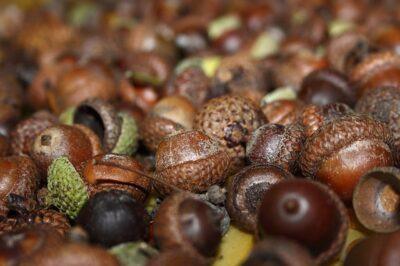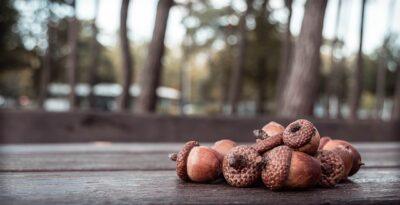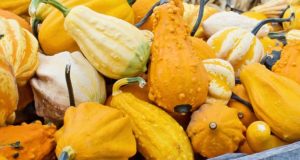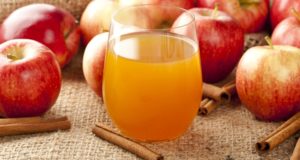Prior to the development of agriculture and hunter-gatherer societies all around the world, acorns were a staple of the human diet. Ancient Romans and early Chinese peoples used them, as did Celts, early Africans and Native-Americans. A single oak tree in a good year can produce 500 to 1,000 pounds of acorns, which are high in protein, carbohydrates and fats.
If you are fortunate enough to have acorn-producing oak trees on your property, you may be sitting on a valuable alternative food source. Oak trees might not produce every year, but acorns can be dried and stored for two to three years. Acorn production can be promoted by reducing competition from nearby trees and insect predation by using fire management techniques to produce larger crops. It is possible to transform one or two oak trees into a sustainable, predictable, nutritious food source.
Harvesting and Storing Acorns
Identify your acorns before gathering, or at least make some observations. There are more than 50 species and hybrids of oaks growing in North America, and they can be difficult to identify. If you’re serious about acorn production and use, you will want a guide, such as the free one offered by the USDA Forest Service. While all acorns are edible, some will require more processing to remove tannins, which are a bitter, astringent chemical found in some plant foods. The amount of tannins in most acorns makes them indigestible and dangerous to humans without processing. One tip for determining the amount of tannins in an acorn is to look at the acorn’s cap size in relation to the seed. The deeper the cap, the more tannins will be in the acorn. Even if they require more preparation time, if the tree is producing a large quantity of acorns it is probably worth the work.
Just 30 Grams Of This Survival Superfood Provides More Nutrition Than An Entire Meal!
Gather your acorns in late fall, after the first have dropped. Oak trees will drop the damaged acorns first, retaining better ones on the tree. If you can gather the acorns while still on the tree, do so. Mature acorns will be brownish and will remove easily from their cap. Pick a few and attempt to remove the caps to ensure they are ready before you gather a lot. You also can collect acorns from the ground, but inspect these ones for holes as acorns are prone to weevils. Expect your processed yield to be about half of your acorn harvest after shelling, leaching and grinding.
Acorns should be tested to eliminate the bad ones before drying. Pour acorns into a bucket of water and discard any that float; these acorns are rotten or contain bugs. Dry the remaining acorns in the sun or in a low-temperature oven. When they are dry, they should crack easily. Store acorns in boxes or cloth bags in a dry room protected from pests. Acorns can be stored for a very long time, but they should be monitored to ensure that they are not becoming moldy and that pests have not found them.
Processing and Eating Acorns
Keep in mind you are using a wild food and there will be a lot of variability in your product. You will probably have to experiment with the best time to harvest, processing methods and recipes. Different varieties of acorns vary in fat and carbohydrate content, meaning their behavior in recipes will vary. These are some of the popular eating acorns: East Coast White Oaks and Valley Oaks for their size and sweetness, and Eastern Red Oak, Live Oaks and Black Oaks for their fat content. The fattier acorns will work almost as nut butters, while sweeter acorns will work more like chickpea flour.
Plan ahead when you want to use acorns, as processing takes several days. You can remove acorns from storage for processing as needed. Crack acorns using a mortar and pestle or a nutcracker if you prefer, and separate the nut from the shell.
The World’s Healthiest Survival Food — And It Stores For YEARS and YEARS!
Grind the nuts in a food processor or with your mortar and pestle, and place in a clean, glass jar. Fill the jar with fresh cold water. Two to three times daily, pour out tannic water (or reserve for natural dyeing) and replace with fresh, cold water, using a cloth or fine strainer to prevent losing acorns. After three to six days, taste the acorn flour to test for sweetness. If it is done leaching it should not be bitter. The prepared ground acorn can be used as flour immediately or stored, wet or dry, in the freezer.
Acorn flour is versatile in cooking and should be thought of as another ground nut. It can be used on its own to make a crumbly pancake by mixing 2 cups of the flour with 1 egg – or another binder – and you can add honey and other spices to taste. Acorn flour also can be used with wheat or oat flours in a 1:1 ratio to create more versatile nut breads, or eaten as porridge by mixing with broth or honey and water.
Although gathering your acorn crop and familiarizing yourself with its virtues will be work, it will reap tremendous rewards as an additional food source for you and your family. This traditional food could very well help you survive through a lean period, as it has for many people before you. Storing and using a food that is so readily available just makes sense – even the squirrels know that!
Have you ever made acorn flour? Share your tips in the section below:
Harness The Power Of Nature’s Most Remarkable Healer: Vinegar
 Off The Grid News Better Ideas For Off The Grid Living
Off The Grid News Better Ideas For Off The Grid Living





